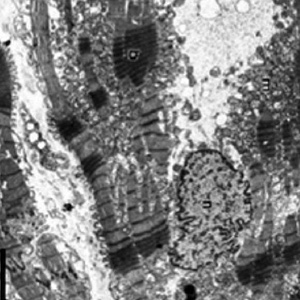Preliminary study on the immunohistochemical expression of galectin-3 in hypertrophic hearts

Published: June 28, 2024
Abstract Views: 962
PDF: 267
Publisher's note
All claims expressed in this article are solely those of the authors and do not necessarily represent those of their affiliated organizations, or those of the publisher, the editors and the reviewers. Any product that may be evaluated in this article or claim that may be made by its manufacturer is not guaranteed or endorsed by the publisher.
All claims expressed in this article are solely those of the authors and do not necessarily represent those of their affiliated organizations, or those of the publisher, the editors and the reviewers. Any product that may be evaluated in this article or claim that may be made by its manufacturer is not guaranteed or endorsed by the publisher.
Similar Articles
- Rafael Vidal-Pérez, Ewa A. Jankowska, The scientific targets: the myocardium, the vasculature and the body’s response to heart failure , Global Cardiology: Vol. 2 No. 1 (2024)
- Maryanne Caruana, Miriam Gatt, Oscar Aquilina, Charles Savona Ventura, Victor Grech, Jane Somerville, The impact of maternal congenital heart disease on pregnancy outcomes in Malta: a retrospective study , Global Cardiology: Vol. 1 No. 1 (2023)
- Eirini Flouda, Athena Stefanatou, Tinia Apergi, Intervention options: depression and cardiovascular disease during COVID-19 , Global Cardiology: Vol. 1 No. 1 (2023)
- Jelena Čelutkienė, Agnė Monika Jakštaitė, Jolita Badarienė, Svetlana Solovjova, Ieva Slivovskaja, Rokas Navickas, Edita Kazėnaitė, Egidija Rinkūnienė, Alma Čypienė, Jonas Misiūra, Ligita Ryliškytė, Aleksandras Laucevičius, Andrew J.S. Coats, Detection of early heart failure with preserved ejection fraction in metabolic syndrome patients detected as part of a national screening program in middle aged subjects , Global Cardiology: Vol. 1 No. 1 (2023)
- Giuseppe M.C. Rosano, Jerneja Farkas, Evolving targets for heart failure: the journey so far , Global Cardiology: Vol. 1 No. 1 (2023)
- Maryanne Caruana, Philip Moons, Adrienne H. Kovacs, Koen Luyckx, Corina Thomet, Werner Budts, Maayke Sluman, Katrine Eriksen, Mikael Dellborg, Malin Berghammer, Bengt Johansson, Alexandra Soufi, Edward Callus, Victor Grech, Silke Apers, Quality of life in Maltese adults with congenital heart disease: a second look , Global Cardiology: Vol. 2 No. 1 (2024)
- Elena Efremova, Alexander Shutov, Adherence to lifestyle therapy in patients with chronic heart failure and comorbidity , Global Cardiology: Vol. 1 No. 1 (2023)
- Giuseppe M.C. Rosano, Clinical trial design, endpoints and regulatory considerations in heart failure , Global Cardiology: Vol. 2 No. 1 (2024)
- Stephan von Haehling, Wolfram Doehner, Ruben Evertz, Tania Garfias-Veitl, Monika Diek, Mahir Karakas, Ralf Birkemeyer, Gerasimos Fillippatos, Piotr Ponikowski, Michael Böhm, Tim Friede, Stefan D. Anker, Iron deficiency in heart failure with preserved ejection fraction: rationale and design of the FAIR-HFpEF trial , Global Cardiology: Vol. 1 No. 1 (2023)
- Reinaldo B. Bestetti, Rosemary Furlan-Daniel, Luciano P. Pereira, COVID-19 myocarditis , Global Cardiology: Vol. 2 No. 1 (2024)
You may also start an advanced similarity search for this article.

 https://doi.org/10.4081/cardio.2024.37
https://doi.org/10.4081/cardio.2024.37














